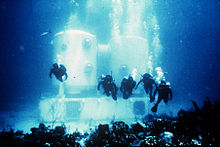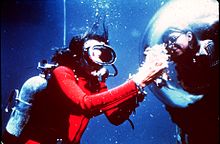Tektite (underwater laboratory)
Tektite was an American underwater laboratory that was used for numerous missions in 1969 and 1970 under the names Tektite I , Tektite II and Minitat .
Origin of name
In order to clarify the connection between oceanography and space travel, it was decided to use the project name Tektite (English for Tektite ). Tektites are glass objects of earth origin up to a few centimeters, the formation of which was caused by the impact of large meteorites on the earth's surface.
Plant and equipment
The Tektite habitat consisted of two steel cylinders on a rectangular platform. The towers were connected to each other by a flexible tunnel and each had two floors with a diameter of 3.8 m and a height of 2.7 m. It thus had a total usable area of 45.36 m². One of the cylinders had a glass observation dome on top. The living areas were furnished with bunk beds for 4 people, cupboards, a sink, oven, refrigerator, radio and television. The bridge contained, among other things, consoles for breathing gas control, alarm and communication. The equipment room had the electrical system, refrigerator and toilet. The wet room contained a fresh water shower, steel tables for specimen examinations as well as a dryer and storage space for equipment.
The facility was designed to be as homely as possible. It also had carpets, good lighting, appealing color schemes and large hemispherical windows in every room. The meals were partly prepared in the habitat.
The platform offered side access to the moon pool and another to the emergency exit of the second cylinder. It also served as a holder for the ballast.
A 300 m long pipe led away the wastewater to a depth of 22 m.
Part of the facility was a supply ship, from which the supervisory director also operated.
The deck pressure chamber (DDC), the person transfer capsule (PTC) and a crane were on a second ship.
intention
In 1967, the American aerospace agency NASA and the US Navy decided to develop an underwater station, the data of which should be able to predict potential problems in the behavior and effectiveness of future astronauts. A design by the General Electric Company was awarded the contract . This constellation resulted in three goals:
- The US Navy was interested in results on diving physiology, small group behavior in isolation, and marine technology.
- NASA was interested in the behavior of small groups with regard to long space missions
- The Ministry of the Interior wanted to expand the capacity for scientific activities on the seabed by researching saturation diving,
The director of the program was Denzil Pauli, and vice director James W. Miller.
Missions
Tektite I
On January 28, 1969, the plant in Greater Lameshur Bay off the island of St. John ( US Virgin Islands ) was deposited on the seabed. The internal pressure was identical to the ambient pressure at a depth of 13.1 m. Unlike other programs, Tektite was not lowered by negative buoyancy, but rather pulled down by winches while it was still about 2265 kg (5000 pounds) of buoyancy. When it reached the sea floor, it was weighted until it showed a negative buoyancy of around 10 t.
On February 15, four Aquanauts entered the facility and stayed there until April 15, 1969. The mission duration of 60 days was not exceeded for 23 years.
The crew breathed a mixture of 92% nitrogen and 8% oxygen, while normal compressed air was used for exits. The aquanauts spent a total of about 432 hours in the water or two hours per person per day. In this Hookah hoses m with a length of 61 or also uses compressed air diving equipment. Exits were limited vertically to a depth of 6.7 m (6.4 m above the habitat) or 25.9 m (12.8 m below the habitat level) and were horizontal to a distance of 549 m Habitat carried out.
At the request of the crew, the temperature within the habitat was kept between 26.7 and 29.4 ° C. The humidity was preferably 50%.
On August 15, 1969, the aquanauts left the habitat and dived 122 m to the person transfer capsule (PTC). After boarding, the capsule was sealed and lifted onto the deck of the second supply ship, where it was coupled to the deck pressure chamber. There they spent 19 hours and 22 minutes of decompression.
Attendees
- A. Waller (group leader)
- John G. Van Derwalker
- Conrad. W. Mahnken
- H. Edward Clifton
Reserve team:
- Ian G. Koblick
- Gary E. Davis
- R. Lawrence Phillips
Documented problems
- As with other missions, there were multiple ear infections due to moisture and humidity.
- Most of the problems arose from technical equipment such as CO 2 filters, TV cameras, surface supply systems, breathing gas monitoring and many others.
Tektite II
The Tektite II program took place between April and November 1970. It consisted of ten missions between 12 and 30 days with five participants each. It was directed by James W. Miller and Richard A. Waller, who canceled the costly supply ships and replaced them with a new ship and shore station.
During this mission, General Electric Mark 10 Mod III rebreather , closed- circuit rebreather , were used which allowed dives of 12 hours, although dives were limited to 4 hours for safety reasons.
As part of a detailed study called the Human Behavior Program , all rooms were equipped with cameras and microphones, while the aquanauts marked their condition several times a day on appropriate control cards.
From April 4, 1970, 53 aquanauts used the habitat for missions between 2 and 4 weeks. 360 students were given the opportunity to deepen their knowledge, including 30 diving technicians from the Highline Community College , Seattle / Washington, who gained practical experience as support divers, and 35 psychology students from the University of Texas who trained in data collection and analysis methods.
A crew of Tektite II consisted exclusively of women and thus formed the first all-female Aquanaut team. In 2013, Dr. Sylvia Earle in an interview that the project management feared that relationship stress would arise if the crew were mixed. For this reason it was preferred to set up a purely female team. The prognosis that there would be friction among women was not confirmed.
Studies carried out
Nine studies were carried out in Tektite I and Tektite II:
- The influence of herbivorous organisms on marine plants in Lameshur Bay, by SA Earle
- Bioacoustic Studies in Reef Organisms, by TJ Bright
- Observations on partner shrimp of the genus Periclimenes, by C. Mahnken
- Of fish pinned cymothoidae - isopods , FG Hochberg, Jr. and RJ Ellis
- The behavior of reef fish on various rheuses, by W. High and AJ Beardsley
- Torpedo bass and the distribution of coarse debris near West Indian coral reefs, by HE Clifton and RE Hunter
- Escape behavior of blue swallowtails and damselfish , by AE Hartline, PH Hartline, AM Szmant, and AO Flechsig
- Activity patterns of coral fish with an emphasis on day and night alternation, by BB Collette and FH Talbot
- Distribution of Open Space in Coral Fish Communities, by CL Smith and JC Tyler
Documented problems
- Apart from the ear infections that had already occurred with Tektite I , there were no other medical problems.
Minitat
With the small Habitat Minitat , a station should be designed that, in contrast to Tektite, should be more mobile. It was intended for a depth of 30 m and was intended to show that longer stays in a nitrogen-oxygen atmosphere were also possible at this depth. For this purpose, a plan was drawn up that provided for 49 hours and 20 minutes of decompression, including two hours and 50 minutes of oxygen breathing, from a depth of 30 m.
The habitat consisted of a small upright cylinder with a diameter of 2.4 m and a height of 3.4 m on a catamaran platform, which served both as a floating body and as an aid to descending and descending. It was used from June 1970.
Documented problems
- Due to a difference between the center of gravity and the center of buoyancy, the habitat tilted 45 ° in the first phase of lowering in order to stabilize again under water.
- The habitat was torn from its anchorage during a night storm and drifted off to be towed back by a local fisherman the next morning. This incident was decisive for the termination of the project on November 6, 1970.
2009 - return after 40 years
Under the organization of the Cruz Bay Watersports company , some of the aquanauts returned to the site of the Tektite program after forty years . First, on February 15, 2009, the Tektite I aquanauts Conrad Mahnken and Edward Clifton, as well as project manager Jim Miller met in the former Tektite land station to open a corresponding museum. Two months later, on May 15, 2009, Buzz Aldrin and 24 alumni, as well as Scott Carpenter, visited the Habitat Program site.
See also
Web links
Individual evidence
- ↑ a b c Bruce B. Collette: Results of the Tektite program: Ecology of coral-reef fishes . Ed .: Natural History Museum, Los Angeles County. Los Angeles 1972 ( si.edu [PDF]).
- ↑ a b c James W. Miller, Ian G. Koblick: Living & Working in the sea . Ed .: Van Nostrand Reinhold Company. New York 1984, ISBN 0-442-26084-9 .
- ↑ http://seabeemagazine.navylive.dodlive.mil/2014/07/17/project-tektite-i-and-the-birth-of-the-underwater-construction-teams/
- ↑ JB Tenney: 2400 hours of saturation diving, a statistical analysis of Tektite II . Ed .: Department of Ocean Engineering, University of Rhode Island. Kingston October 1971 (English).
- ^ Tektite 2: Behavioral Observer Handbook . NASA CR-126699.
- ^ Robert Helmreich: The Tektite II Human Behavior Program: Human reactions to psychological Stress, Technical Report No. 14 . Ed .: The University of Texas at Austin. March 1971 (English).
- ↑ Roger Moenks, Sylvia Earle: I am ecowarrior: Sylvia Earle: No Hanky Panky on the Reef, the Real Story Behind the Tektite II. September 4, 2015, accessed on October 23, 2016 (English).
- ↑ Virgin Islands Guide vinow.com: A 40 Year Reunion - Tektite I & II. Retrieved January 3, 2017 (English).




